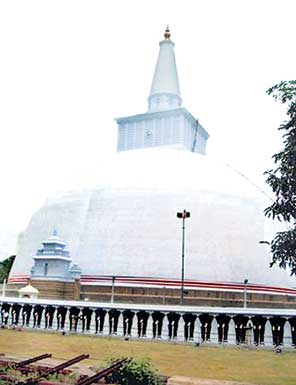| Ruwanveli Seya gets ready for Poson Poya | |
| By D.C. Ranatunga - The Sunday Times | |
It's around six in the evening. We are in the 'salapatala maluva' - the stone-paved compound at Ruwanveli Seya, the hallowed place of worship in Anuradhapura. This is the area where devotees offer flowers and other offerings and worship the stupa. We hear cries of 'sadhu', 'sadhu'. We look towards the main entrance. What a sight! Devotees of all ages – men, women and children – come up the steps and start going round the stupa carrying a deep brown robe. The robe is spread out and they carry it above their heads.
The cries of 'sadhu' continue. It looks a never-ending procession. They are carrying a robe 280 metres long, sufficient to go right round the stupa. We watch the procession gradually moving away from us. Once a full round is made, a few monks climb on to the area just above the three terraces ('pesavas') and start placing the robe to cover the stupa. This is the climax of an annual event after the Ruwanveli Seya gets a new coat of paint in time for Poson Poya when devotees in their thousands throng to the holy city. Annually 'sudu hunu' – a mix of chunam and salt - is applied to give a new look to the great stupa. On completion of the gigantic task, which is administered by the office of the Public Trustee, a 'pinkama' is held. A robe or the Buddhist flag is spread out covering the stupa, 'Buddha puja' is offered, and a monk delivers a sermon tracing the history of the Ruwanveli Seya and explaining the tremendous amount of merit gained by the devotees who undertake this mammoth task. The cost of the operation has been rising year after year and today stands at Rs. 3.5 million. Ten years ago the figure was around Rs. 500,000. The wages for about 50 workmen for a period of nearly three months in itself add up to a tidy sum. Yet there is never a problem in finding philanthropists to undertake the job. If no one comes forward, the Public Trustee publishes an advertisement in the newspapers. The response has always been most favourable. With Poson just a few days away, the dagoba is a blob of white. When lights are switched on at 6.30 in the evening, it's a beautiful sight. The dagoba as well as the compound is well illuminated. A cool breeze blows across. There is silence all round. It's an ideal setting for the devotees to recite the stanzas, to chant 'pirith' and to meditate. For security reasons, gates are closed at 9 p.m. About the stupa Though not the tallest stupa in Anuradhapura, Ruwanveli Seya is the most impressive and imposing possibly because over the years it has been maintained well. Referred to as the Maha Thupa in the Mahavamsa, Great Chronicle, it was built by warrior king Dutugemunu in the 2nd century B C to a height of 73.2 metres. The fact that a large quantity of corporeal relics of the Buddha had been enshrined in the stupa makes it so popular among the devotees. Many are the legends relating to the construction of Ruwanveli Seya. The way the materials had been obtained is fascinating reading. As for the design, a master-builder named Sirivaddhaka is supposed to have taken a golden bowl filled with water, poured a little water into his hand and let it fall on the surface of the ball. Then a great bubble rose up. "Thus will I make it," the master-builder said. King Dutugemunu liked it and rewarded him with cash and kind. |
The Triple Gem ! A Buddhist site With Dhamma, Sanga, by , Priyantha De silva,"The Future Global Education Center", Hittatiya East, Matara, sri Lanka. A Dhamma links, Bana , Sermons, Online Buddhist TV , buddhist radio stations links,You are very important to us with your participation to this blog.Make creative Ideas that will fetch others to highest place of Nibbana !That mean Ultimate Happiness. May Lord Buddha Bless You ! May The Triple Gem Bless you !
Thursday, July 24, 2008
Ruwanveli Seya In Sri Lanka , For the Last Poya Day
Subscribe to:
Post Comments (Atom)


No comments:
Post a Comment